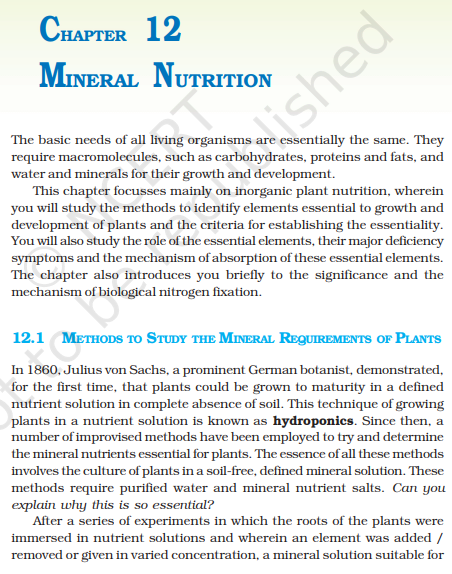‘NCERT Solutions for Class 11 Biology Chapter 12 Mineral Nutrition’ PDF Quick download link is given at the bottom of this article. You can see the PDF demo, size of the PDF, page numbers, and direct download Free PDF of ‘Ncert Class 11 Biology Chapter 12 Exercise Solution’ using the download button.
Mineral Nutrition NCERT Textbook With Solutions PDF Free Download

Chapter 12: Mineral Nutrition
The basic needs of all living organisms are essentially the same. They require macromolecules, such as carbohydrates, proteins, fats, and water and minerals for their growth and development.
This chapter focuses mainly on inorganic plant nutrition, wherein you will study the methods to identify elements essential to the growth and development of plants and the criteria for establishing the essentiality.
You will also study the role of the essential elements, their major deficiency symptoms, and the mechanism of absorption of these essential elements.
The chapter also introduces you briefly to the significance and the mechanism of biological nitrogen fixation.
12.1 METHODS TO STUDY THE MINERAL REQUIREMENTS OF PLANTS
In 1860, Julius von Sachs, a prominent German botanist, demonstrated, for the first time, that plants could be grown to maturity in a defined nutrient solution in the complete absence of soil. This technique of growing plants in a nutrient solution is known as hydroponics.
Since then, a number of improvised methods have been employed to try and determine the mineral nutrients essential for plants.
The essence of all these methods involves the culture of plants in a soil-free, defined mineral solution. These methods require purified water and mineral nutrient salts. Can you explain why this is so essential?
After a series of experiments in which the roots of the plants were immersed in nutrient solutions and wherein an element was added/removed or given in varying concentrations, a mineral solution suitable for the plant growth was obtained.
By this method, essential elements were identified and their deficiency symptoms discovered.
Hydroponics has been successfully employed as a technique for the commercial production of vegetables such as tomatoes, seedless cucumber, and lettuce.
It must be emphasized that the nutrient solutions must be adequately aerated to obtain optimum growth. What would happen if solutions were poorly aerated? Diagrammatic views of the hydroponic technique is given in Figures.
12.2 Essential Mineral Elements
Most of the minerals present in soil can enter plants through roots. In fact, more than sixty elements of the 105 discovered so far are found in different plants.
Some plant species accumulate selenium, some others gold, while some plants growing near nuclear test sites take up radioactive strontium.
There are techniques that are able to detect the minerals even at a very low concentration (10-8 g/mL).
The question is, whether all the diverse mineral elements present in a plant, for example, gold and selenium as mentioned above, are really necessary for plants? How do we decide what is essential for plants and what is not?
12.2.1 Criteria for Essentiality
The criteria for the essentiality of an element are given below:
(a) The element must be absolutely necessary for supporting normal growth and reproduction.
In the absence of the element, the plants do not complete their life cycle or set the seeds.
(b) The requirement of the element must be specific and not replaceable by another element. In
other words, the deficiency of any one element cannot be met by supplying some other element.
(c) The element must be directly involved in the metabolism of the plant.
| Author | NCERT |
| Language | English |
| No. of Pages | 12 |
| PDF Size | 2.2 MB |
| Category | Biology |
| Source/Credits | ncert.nic.in |
NCERT Solutions Class 11 Biology Chapter 12 Mineral Nutrition
1. ‘All elements that are present in a plant need not be essential to its survival. Comment
Solution:
No, out of 105 elements absorbed by plants only about 17 elements are essential for plant growth and survival.
2. Why is the purification of water and nutrient salts so important in studies involving mineral nutrition using hydroponics?
Solution:
Hydroponics is a method of growing plants in the nutrition solution in the absence of soil. There are plenty of impurities in impure water in the form of soluble minerals that are dissolved in it.
If this water is used as a solution culture to grow plants in hydroponics, these impurities will interfere with the experimental procedure used to detect the elements.
Hence, pure water and purified nutrient salts are utilized in studies involving mineral nutrition using hydroponics.
3. Explain with examples: macronutrients, micronutrients, beneficial nutrients, toxic elements, and essential elements.
Solution:
Macronutrients – Nutrients present in more than 10mmole kg-1 of dry matter in plant tissues are known as macronutrients. They are required in large amounts for plant growth. Ex: Carbon, Hydrogen, Oxygen, Nitrogen, Phosphorus, Sulphur, Potassium, calcium, and magnesium.
Micronutrients – are the trace elements present in less than 10mmole kg-1 of dry matter in plants. Example – manganese, copper, zinc, boron, nickel
Beneficial elements – In addition to 17essential nutrients there are some beneficial elements required by higher plants in addition to micro and macronutrients. Ex: Sodium, Silicon, Cobalt, and selenium.
Toxic elements are those which are required in trace amounts. Their deficiency causes diseases in plants and excess in such nutrients is toxic to plants. Ex: Sodium, Potassium, Magnesium.
Essential elements – It is an element that directly interferes in the metabolism of the plant causing a specific deficiency symptom if not available to plants from an external source.
4. Name at least five different deficiency symptoms in plants. Describe them and correlate them with the concerned mineral deficiency.
Solution:
Chlorosis: Loss of chlorophyll leading to the yellow coloration of the leaves. It is caused by the deficiency of N,
K, Mg, S, Fe, Mn, Zn and Mo.
Necrosis: It is the death of leaf tissue due to deficiency of Ca, Mag, Cu, and K. It is the killing of cells expressed in the form of leaf spots, rots, and blights.
Inhibition of cell division: deficiency in Mo, N, K, and S causes inhibition of Cell division. They are expressed in stunted growth
Delay in flowering: In some plants, it is caused due to low concentrations of N, S, and Mo.
Deformation – It is caused due to deficiency of boron. Deformation, disorganization, discoloration of the meristematic tissue, and ultimately death of a growing plant.
5. If a plant shows a symptom which could develop due to deficiency of more than one nutrient, how would you find out experimentally, the real deficient mineral element?
Solution:
Plants that show symptoms of multiple nutrient deficiencies grow in different sets in water culture.
Set 1, 2, and 3 are given three different nutrients and are grown in hydroponics by supplementing one of the different nutrients showing deficiency. If the real deficient element is supplemented then the plant will grow normally without showing deficiency symptoms.
NCERT Class 11 Biology Textbook Chapter 12 Mineral Nutrition With Answer PDF Free Download
